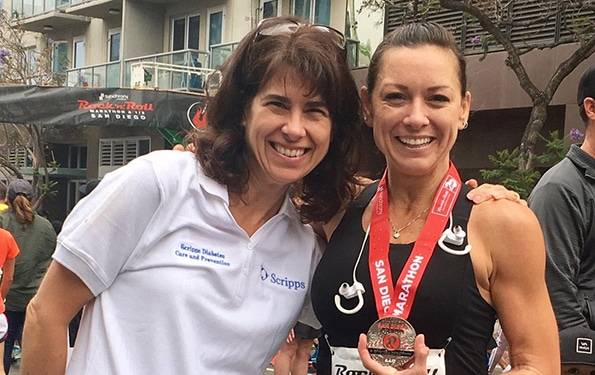New Technology Helps Diabetic Mother of Two Finish her First Full Marathon
Device learned rhythms of the body and kept blood sugar steady during race

Device learned rhythms of the body and kept blood sugar steady during race
Kristy Castillo never thought she would be able to run and finish a full marathon. She has type 1 diabetes and her body doesn't produce the insulin needed to process sugar and produce energy.
“In general – my blood sugars go up and down,” said Castillo. “I’m a classic type one, which has been a roadblock to engaging in intense activity."
On Sunday, June 4, 2017, Castillo finished the 26.2 mile Rock ‘n’ Roll Marathon in San Diego while wearing the latest technology – a hybrid closed loop insulin pump to control her blood sugar throughout the race.
Dr. Athena Philis-Tsimikas, corporate vice president of the Scripps Whittier Diabetes Institute, said the device is life-changing for patients.
"Previously, patients had to think of everything about how to monitor glucose levels and inject their insulin. Now that process can be automated," said Dr. Tsimikas.
A single mother of two, Castillo has been living with diabetes for more than 20 years. After her divorce, she wanted to channel her energy into something therapeutic, so she chose running. She completed a few half marathons, but not without complications.
“I was pushing myself to get to the finish line to get insulin,” Castillo said. “I could get severe hyperglycemia when training and hypoglycemia during long runs.”
Castillo’s Scripps Clinic endocrinologist, Megan McGarvey, MD, helped her integrate the new continuous glucose monitoring (CGM) system into her routine. It can measure glucose levels in real-time throughout the day and night.
"While I was training, the device learned the rhythms of my body and began keeping my blood sugar steady during intense runs," Castillo said. “The longer I wear it the smarter the pump gets.”
Castillo started and finished the race with perfect blood sugar numbers, 144 and 158.
“When I set my mind to something, I don’t back down,” said Castillo.
Dr. Tsimikas noted that Castillo’s story is an example of how a motivated patient and dedicated care team can work together to overcome a tough disease.